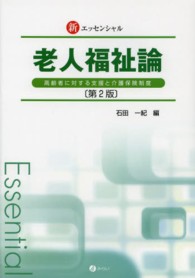- ホーム
- > 洋書
- > 英文書
- > Architecture
Full Description
Transnational Architecture and Urbanism combines urban planning, design, policy, and geography studies to offer place-based and project-oriented insight into relevant case studies of urban transformation in Europe, North America, Asia, and the Middle East.
Since the 1990s, increasingly multinational modes of design have arisen, especially concerning prominent buildings and places. Traditional planning and design disciplines have proven to have limited comprehension of, and little grip on, such transformations. Public and scholarly discussions argue that these projects and transformations derive from socioeconomic, political, cultural trends or conditions of globalization. The author suggests that general urban theories are relevant as background, but of limited efficacy when dealing with such context-bound projects and policies.
This book critically investigates emerging problematic issues such as the spectacularization of the urban environment, the decontextualization of design practice, and the global circulation of plans and projects. The book portends new conceptualizations, evidence-based explanations, and practical understanding for architects, planners, and policy makers to critically learn from practice, to cope with these transnational issues, and to put better planning in place.
Contents
List of figures
List of tables
Introduction
PART I - Transnational architecture and urbanism
1 The transnational transformations of contemporary cities
1.1 Ubiquitous and homogenizing forces of urban globalization?
1.2 Global spread and local transplants: past and recent examples
1.3 Contemporary urban narratives, models and projects
1.4 City forms and transnational projects: pressing issues and questions
2 Looking for (urban) troubles across disciplines
2.1 The architecture/city nexus: old criticisms and contemporary reductions to absurdity
2.2 Forms of contemporary urban development: Manhattanism, bigness and the generic post-metropolis
2.3 Glocal urban competition and growth machines
2.4 Contemporary architectural and urban knowledge is part of the problem
3 A Conceptual framework for usable knowledge in contemporary cities
3.1 Projects and built forms
3.2 Glocal places and contexts
3.3 Transnational agents and networks
3.4 Transnational urban processes
3.5 Analyzing transnational projects through their mobilities, circulation, and transfer
3.6 A conceptual framework for usable knowledge, not for general urban theories
4 Critical approach and pragmatic attitude
4.1 Long-term global mapping and urban analysis: forms, agents and process
4.2 The case study method and its limits in investigating transnational issues
4.3 Methods for critically understanding transnational architecture and urbanism
PART II - Critical issues
5 Spectacularization of contemporary architecture and the urban environment
5.1 Architecture in the society of spectacle
5.2 Urban politics and the economies of spectacle
5.3 Transnational cultural facilities and their urban expectations: the Guggenheim spectacles
5.4 The city wonders in the world: supertall skyscrapers
5.5 The Burj Khalifa in Downtown Dubai and beyond
5.6 Placing urban spectacles
6 Urban personification and the mobilities of global experts
6.1 Archistars, urbanistars and other transnational elites
6.2 The "New York by Gehry" building and other personifications
6.3 Hadid's, Libeskind's and Isozaki's projects and the poor planning of Milan's CityLife
6.4 Mobilities of urbanistars and planning consultancy groups
6.5 Transnational experts and local landings
7 Decontextualization of architectural and urban design
7.1 Economic and symbolic competitions in a financialized urban world
7.2 Transnational design firms' strategies in contemporary cities
7.3 The transnational trajectories of Broadway Malyan's firm and projects
7.4 Transnational urban development and the disconnect of its design
8 Plan circulation and complex transfers
8.1 New York's High Line Elevated Park and its transnational circulation
8.2 The circulation of a master plan from Vancouver's False Creek to Dubai Marina and beyond
8.3 Transferring an urban complex: from Abu Dhabi's Central Market to Abu Dhabi Plaza in Astana
9 Transfer of megastructures and buildings
9.1 Singapore's new landmark transferred to Chongqing
9.2 From Barcelona's Poblenou to Doha's West Bay: the take-off and landing of an iconic skyscraper
9.3 Understanding the qualities of transnational places and projects
10 Homogenization of central places and urban landscapes
10.1 Homogenization in contemporary cities
10.2 Five ways of comprehending urban homogenization
10.3 Transnational geographies and dynamics of urban homogenization
PART III - Conclusions
11 Planning, learning and dealing with transnational architecture and urbanism
11.1 Varied relevance of local planning and the legitimization crisis of urban and design knowledge
11.2 A state of unlearning: speed, scale and de-politicization of urban planning and architectural design
11.3 The little room for maneuvering and for making better places
12 How can urban planners, designers and policy makers cope with these issues?
12.1 Contextual learning from transnational plans and projects
12.2 Less about transnational narratives, more about local problems
12.3 Critical paths for research and practice across urban design, planning and policy making
References
Indexes






